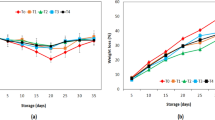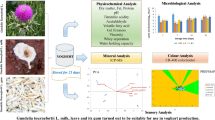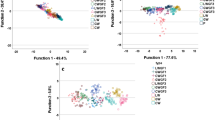Abstract
Tapioca-based boba pearls have a high calorific value, which can induce health risks. Seaweed materials are considered healthier alternatives to tapioca flour because of their low calorific value and their lipids, high fiber content, and bioactive compounds. This study evaluated the calorific value and quality parameters of boba pearls formulated using Indonesian seaweed Gracilaria sp. agar powder. Three seaweed-enhanced boba pearl variants were prepared by substituting seaweed agar for either 5 (F05), 10 (F10), or 15% w/w (F15) of tapioca flour and then compared to the control and commercial boba pearls. Duplicate sub-samples from each treatment were assessed for sensory quality, calorific value, proximate composition, pH, and microbial concentration. The results indicated that the F15 variant had a lower calorific value (9.09 kJ g−1) trend than the control and commercial samples. The F15 variant had a higher total protein (0.96% FW), ash (0.44% FW), and moisture content (45.51% FW), with lower total lipid (0.21% FW) and total carbohydrate (52.89% FW) trends compared to the control. The F15 variant also had a higher total protein and moisture content, with lower lipid, ash, and total carbohydrate contents than the commercial samples. The F15 variant had the same pH (5) as the control but was higher than the commercial samples. Furthermore, the F15 variant had a lower microbial concentration (6.9 × 104 CFU mL−1) than the control, but higher than the commercial samples. The overall sensory quality of the F15 variant (6) was comparable to that of control and commercial samples.


Similar content being viewed by others
Data availability
All data generated or analyzed during this study are included in this published article and its supplementary information files.
References
Aisyah S, Agustiana A, Siregar TM, Putri RA, Rahmawati H (2023) Formulation and nutrition of boba tilapia fish and seaweed as a Generation Z immune boost drink. Russ J Agric Soc-Econ Sci 3:157–161
Alibaba (2023) High quality tapioca pearl raw material for Taiwan milk tea. https://www.alibaba.com/product-detail/High-Quality-Tapioca-Pearl-raw-material_1600274068046.html?spm=a2700.galleryofferlist.normal_offer.d_title.53bb2df0YclwTf. Accessed 24 July 2023
Álvarez-Viñas M, Flórez-Fernández N, Torres MD, Domínguez H (2019) Successful approaches for a red seaweed biorefinery. Mar Drugs 17:620
Ambarita AT, Sudaryati E, Nasution E (2018) Pengaruh penambahan tepung ceker ayam ras terhadap daya terima dan kandungan gizi mutiara tapioka (tapioca pearl) [The effect of chicken claw flour addition on the acceptance and nutritional content of tapioca pearl]. Jurnal Gizi, Kesehatan Reproduksi dan Epidemiologi 1:301–316
[AOAC] Association of Official Analytical Chemists (2005) Official method of analysis of AOAC International, 18th edition. Association of Official Analytical Chemists International, Gaithersburg
Baker P, Friel S (2014) Processed foods and the nutrition transition: evidence from Asia. Obes Rev 15:564–577
Baker P, Machado P, Santos T, Sievert K, Backholer K, Hadjikakou M, Russell C, Huse O, Bell C, Scrinis G, Worsley A, Friel S, Lawrence M (2020) Ultra-processed foods and the nutrition transition: Global, regional and national trends, food systems transformations and political economy drivers. Obes Rev 21:e13126
Barokah D (2022) Pengaruh penambahan tepung rumput laut merah (Eucheuma cottonii) terhadap karakteristik fisik, sensori dan kandungan serat pangan pada bola boba [The effect of additional red seaweed flour (Eucheuma cottonii) on physical, sensory characteristics and dietary fiber content in boba bubble]. BScThesis, Universitas Sriwijaya, Indonesia 44 p
Bubin SFA, Ali SM, Shukri R, IbadullahWZW RNS, Mustapha NA, Rashedi IFM (2019) Characterization and stability of pitaya pearls from hydrocolloids by reverse spherification. Int J Food Prop 22:1353–1364
Contrive Datum Insights (2023) Bubble Tea Market Size, Share & Trends Estimation Report By Type (Black Tea, Green Tea, Oolong Tea, and White Tea), By Flavor (Original, Fruit, Chocolate, Coffee, and Others), By Region, And Segment Forecasts, 2023 - 2030. https://www.contrivedatuminsights.com/product-report/bubble-tea-market-248561/. Accessed 21 July 2023
de Almeida CLF, Falcão H de S, Lima GR de M, Montenegro C de A, Lira NS, de Athayde-Filho PF, Rodrigues LC, de Souza M de FV, Barbosa-Filho JM, Batista LM (2011) Bioactivities from marine algae of the genus Gracilaria. Int J Mol Sci 12:4550–4573
Directorate of Business and Investment (2019) Peluang Usaha dan Investasi Rumput Laut [Seaweed Business and Investment Opportunities]. Directorate of Business and Investment, DJPDSPKP, Ministry of Marine Affairs and Fisheries of the Republic of Indonesia, Jakarta
Du X, Xu Y, Jiang Z, Zhu Y, Li Z, Ni H, Chen F (2021) Removal of the fishy malodor from Bangia fusco-purpurea via fermentation of Saccharomyces cerevisiae, Acetobacter pasteurianus, and Lactobacillus plantarum. J Food Biochem 45:e13728
Fadhlullah M, Prasetyati SB, Pudoli I, Lo C (2022) Preliminary economic potential evaluation of seaweed Gracilaria sp. biomass waste as bioindustry feedstock through a biorefinery approach: a case study in Karawang, Indonesia. J Biol Sci Technol Manage 4:42–53
[FAO] Food and Agriculture Organization (2002) Food energy – Methods of analysis and conversion factors. Food and Agriculture Organization of The United Nations, Rome
[FAO] Food and Agriculture Organization (2022) The State of World Fisheries and Aquaculture 2022: Towards Blue Transformation. Food and Agriculture Organization of The United Nations, Rome
Fortune Business Insights (2023) Bubble Tea Market Size, Share & COVID-19 Impact Analysis, By Type (Black Tea, Green Tea, Oolong Tea, and White Tea), By Flavor (Original, Fruit, Chocolate, Coffee, and Others), and Regional Forecast, 2023–2030. https://www.fortunebusinessinsights.com/industry-reports/bubble-tea-market-101564. accessed 21 July 2023
Francavilla M, Franchi M, Monteleone M, Caroppo C (2013) The red seaweed Gracilaria gracilis as a multi products source. Mar Drugs 11:3754–3776
Gordon E (2011) Broccoli or Broken Windows? The relationship between anti social behaviour and a nutrient deficient diet. https://citeseerx.ist.psu.edu/document?repid=rep1&type=pdf&doi=52684bfefd676acdb419d28d6a42114218c0b4cd. Accessed 29 July 2023
Hikmah H (2015) Strategy of commodity processing industry development E. cottonii seaweed to increasing value added in the area E. cottonii seaweed to increasing value added in the area center of industrialization. Jurnal Kebijakan Sosial Ekonomi Kelautan dan Perikanan 5:27–36
Jayasinghe PS, Pahalawattaarachchi V, Ranaweera KKDS (2019) Dietary fiber content, fatty acid and starch digestible rate of seaweed and seaweed based products in Sri Lanka. Acta Sci Nutr Health 3:143–146
Kaur B, Quek RYC, Ng GCF, Ponnalagu S, Henry CJ (2022) Comparison of boba pearls made from tapioca starch and other unconventional flours and starches: Their glycaemic response (GR). Malays J Nutr 28:357–368
Liu Y, Cheng H, Wu D (2021) Preparation of the orange flavoured “boba” ball in milk tea and its shelf-life. Appl Sci 11:200
Lu LW, Chen JH (2022) Seaweeds as ingredients to lower glycemic potency of cereal foods synergistically—A perspective. Foods 11:714
Maust LE, Scott ML, Pond WG (1972) The metabolizable energy of rice bran, cassava flour, and blackeye cowpeas for growing chickens. Poult Sci 51:1397–1401
Min JE, Green DB, Kim L (2017) Calories and sugars in boba milk tea: Implications for obesity risk in Asian Pacific Islanders. Food Sci Nutr 5:38–45
Muchlissoh F (2019) Potensi Stenotrophomonas maltophilia LA3B sebagai Agen Pupuk Hayati Berbasis Residu Limbah Padat Industri Agar-agar dan Tepung Ikan [Stenotrophomonas maltophilia LA3B Prospective as a Biofertilizer Agent Based on Solid Waste Residues from the Agar and Fish Meal Industry]. BSc Thesis, Universitas Islam Negeri Syarif Hidayatullah Jakarta, Indonesia 78 pp
[NSAI] National Standardization Agency of Indonesia (1992) SNI 01–2891–1992: Cara uji makanan dan minuman [Food and drink testing methods]. National Standardization Agency of Indonesia, Jakarta
[NSAI] National Standardization Agency of Indonesia (2006) SNI 01–2346–2006: Petunjuk pengujian organoleptik dan atau sensori [Guidelines for organoleptic and or sensory test]. National Standardization Agency of Indonesia, Jakarta
[NSAI] National Standardization Agency of Indonesia (2015) SNI 2332.3:2015: Cara uji mikrobiologi - Bagian 3: Penentuan Angka Lempeng Total (ALT) pada produk perikanan [Microbiology testing methods - Part 3: Total Plate Count (TPC) determination for fisheries products]. National Standardization Agency of Indonesia, Jakarta
Neta MTSL, Narain N (2018) Volatile components in seaweeds. Examines Mar Biol Oceanogr 2:195–201
Noviani S (2021) Karakteristik fisik dan kimia boba dari pati ganyong dan rumput laut (Eucheuma cottoni) [Physical and chemical characteristics of the boba of ganyong starch and seaweed (Eucheuma cottoni)]. BSc Thesis, Universitas Sriwijaya, Indonesia 49 p
Puspita M, Setyawidati NAR, Pangestuti R (2020) Hydrocolloid production of Indonesian seaweeds. In: Kim SK (ed) Encyclopedia of marine biotechnology. John Wiley & Sons, New Jersey, pp 407–416
Rajapakse N, Kim SK (2011) Nutritional and digestive health benefits of seaweed. Adv Food Nutr Res 64:17–28
Rosa CS, Tessele K, Prestes RC, Silveira M, Franco F (2015) Effect of substituting of cocoa powder for carob flour in cakes made with soy and banana flours. Int Food Res J 22:2111–2118
Rosemary T, Arulkumar A, Paramasivam S, Mondragon-Portocarrero A, Miranda JM (2019) Biochemical, micronutrient and physicochemical properties of the dried red seaweeds Gracilaria edulis and Gracilaria corticata. Molecules 24:2225
Sany IP, Romadhon R, Fahmi AS (2019) Physicochemical characteristics and antioxidant activity of solid soap enriched with crude Eucheuma cottoni extract. IOP Conf Ser Earth Environ Sci 246:012066
Soethoudt JM, Axmann HB, Kok MG (2022) Indonesian seaweed supply chain: Analysis and opportunities. Wageningen Food & Biobased Research, Wageningen. Report 2309. pp 1–42
The Business Times (2022) S-E Asia spends US$3.7b on bubble tea in 2021, Indonesia tops list: report. https://www.businesstimes.com.sg/international/asean/s-e-asia-spends-us37b-bubble-tea-2021-indonesia-tops-list-report. Accessed 24 July 2023
Verified Market Research (2023) US Bubble Tea Market Size By Ingredients (Black Tea, Green Tea, Oolong Tea), By Flavors (Original, Chocolate, Coffee, Fruit), By Component (Flavor, Creamer, Sweetener, Liquid Tapioca) And Forecast. https://www.verifiedmarketresearch.com/product/us-bubble-tea-market/#:~:text=US%20Bubble%20Tea%20Market%20size%20was%20valued%20at%20USD%20505.12,7.42%20%25%20from%202023%20to%202030. Accessed 21 July 2023
Yusof ASM, Dom ZM, Shamsudin R (2020) Utilization of sweet potato in development of boba. Adv Agric Food Res J 1:a0000149
Acknowledgements
The authors acknowledge Karawang Polytechnic of Marine and Fisheries, the Ministry of Marine Affairs and Fisheries of the Republic of Indonesia for facilitating this study. The authors also acknowledge Koperasi Mina Agar Makmur (Karawang Regency, Indonesia) for providing seaweed agar powder used in this study.
Funding
No funding was received to assist with the preparation of this manuscript.
Author information
Authors and Affiliations
Contributions
All authors contributed to study conceptualization, methodology, and resources. Iqbal Salas performed the investigation, while Iqbal Salas and Muhammad Fadhlullah conducted the formal analysis. Muhammad Fadhlullah and Catur Promono Adi did the supervision, while Iqbal Salas and Muhammad Fadhlullah wrote the first draft of the manuscript. All authors commented on the previous versions and read and approved the final manuscript.
Corresponding author
Ethics declarations
Competing interests
The authors have no competing interests to declare that are relevant to the content of this article.
Additional information
Publisher's Note
Springer Nature remains neutral with regard to jurisdictional claims in published maps and institutional affiliations.
Supplementary Information
Below is the link to the electronic supplementary material.
Rights and permissions
Springer Nature or its licensor (e.g. a society or other partner) holds exclusive rights to this article under a publishing agreement with the author(s) or other rightsholder(s); author self-archiving of the accepted manuscript version of this article is solely governed by the terms of such publishing agreement and applicable law.
About this article
Cite this article
Salas, I., Fadhlullah, M. & Adi, C.P. Calorific values and characteristics of boba pearls with partial formulation from Indonesian seaweed Gracilaria sp. agar powder. J Appl Phycol 36, 433–440 (2024). https://doi.org/10.1007/s10811-023-03139-0
Received:
Revised:
Accepted:
Published:
Issue Date:
DOI: https://doi.org/10.1007/s10811-023-03139-0




